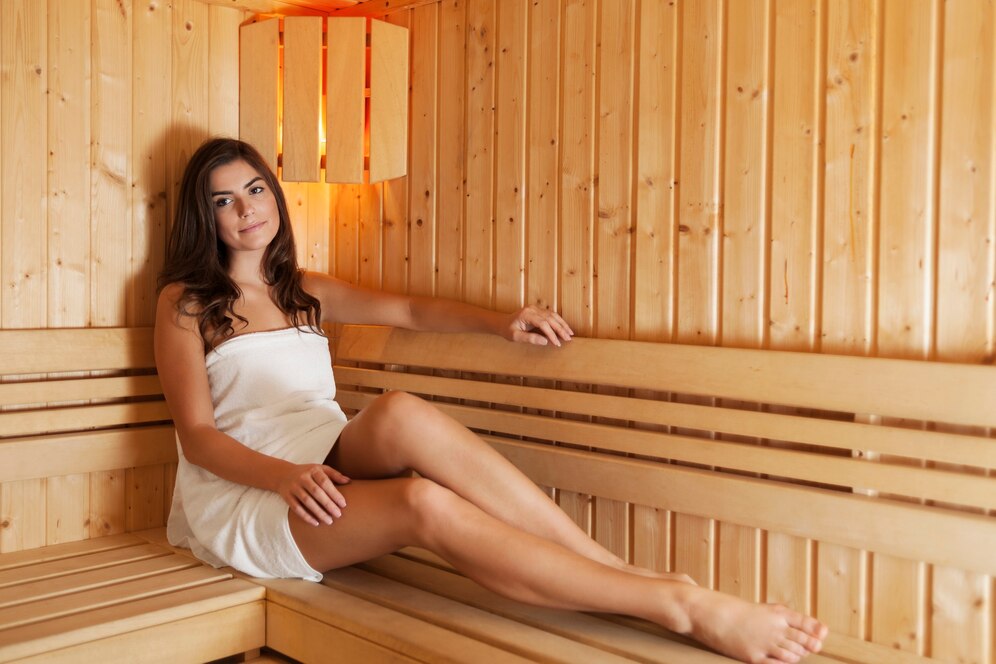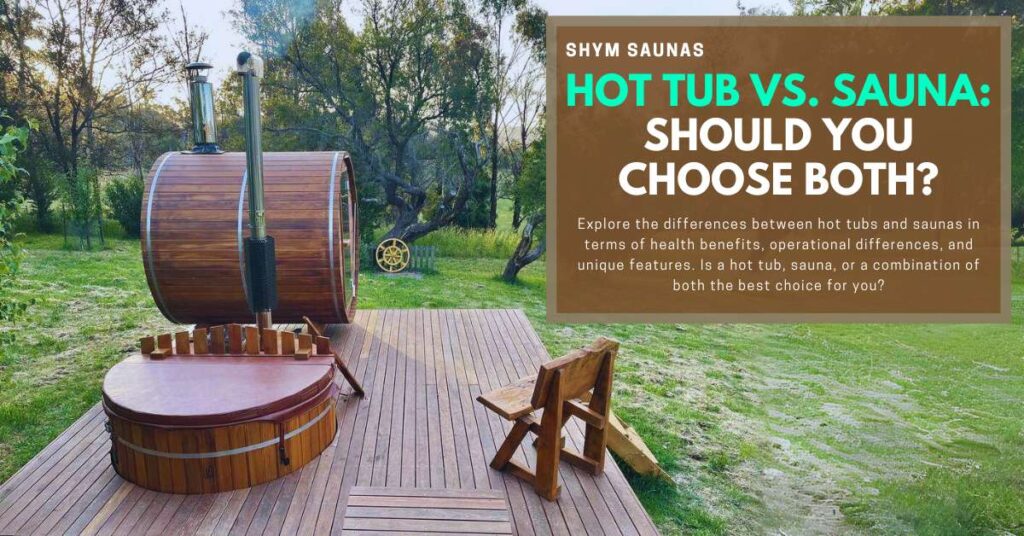Deciding between a hot tub versus a sauna for your home wellness setup can be challenging, as both offer significant health benefits and unique experiences. This guide delves into the operation, health benefits, and features of hot tubs and saunas to help you make an informed decision.
Or, you might find that combining both could offer you the ultimate wellness experience. Let’s dive into the key considerations for each option and explore whether a hot tub, sauna, or a combination of both fits best for you.
Key Takeaways:
- Hot tubs offer hydrotherapy benefits, easing joint and muscle pain, and may lower blood sugar levels, which is beneficial for type 2 diabetes management.
- Saunas provide intense heat exposure, improving lung function, insulin sensitivity, and could potentially increase longevity through cardiovascular benefits.
- Combining a hot tub and sauna allows for a versatile therapy experience, enhancing relaxation, stress relief, and overall health.
- Consider your space, budget, and maintenance willingness before deciding, and consult a healthcare provider if you have health concerns.
Hot Tubs vs. Sauna
Both offer a relaxing escape and deliver health benefits from stress relief to improved cardiovascular health. Harvard Medical School highlights that regular use of either can boost heart health and even prevent heart attacks and strokes.
Hot tubs leverage the power of hydrotherapy, combining heat with the buoyancy of water to relieve joint and muscle pain, while saunas offer intense heat exposure that promotes detoxification and relaxation. With each having its own set of advantages, depending on your personal health needs and preferences, you might find yourself leaning towards one more than the other.
However, why choose when you can potentially enjoy the best of both worlds? Combining a hot tub and sauna could offer you a comprehensive heat therapy experience right in the comfort of your home. Read on to learn more.
Hot Tub Benefits

Hot tubs, with their unique combination of heated water and massage jets, offer numerous health benefits that are both immediate and accumulative:
1. Hydrotherapy
The therapeutic properties of hot tubs come from hydrotherapy, which involves the use of water for pain relief and treatment. The warm water increases blood flow and circulation, helping to soothe muscle pain and stiffness, particularly beneficial for arthritis and chronic pain sufferers.
2. Cardiovascular Health
Immersing your body in hot water raises your heart rate and improves circulation, similar to the effects of a mild exercise. This cardiovascular workout helps in reducing blood pressure and improving heart health.
3. Stress and Pain Relief
The buoyancy of the water reduces body weight by approximately 90%, lessening stress on joints and facilitating easier and pain-free movement. This buoyancy combined with the warm water can significantly alleviate pain linked to fibromyalgia and other musculoskeletal disorders.
4. Mental Wellness
Regular use of a hot tub can also improve mental and emotional health. The relaxing effects of warm water can decrease levels of stress and anxiety, while promoting a restful sleep.
Sauna Benefits

Source: Freepik
Saunas provide health benefits through their use of dry or wet heat, which induces deep sweating and increased heart rate, similar to those experienced during moderate exercise:
1. Detoxification
By inducing sweat, saunas help flush toxins from the body. The heat causes the body’s temperature to rise, stimulating sweat glands and releasing built-up toxins in the process.
2. Respiratory Benefits
Sauna therapy can improve lung function and relieve congestion, particularly beneficial for those with asthma or bronchitis. The warm air helps open airways, which reduces resistance and improves airflow.
3. Skin Health
The deep sweating achieved in a sauna can also cleanse the skin. As sweat travels through the ducts, it carries dead skin cells and other impurities from the upper layers of the skin.
4. Pain Relief and Muscle Relaxation
The heat of the sauna relaxes body muscles, increases circulation, and can speed up the healing of minor bruises and cuts. For those with chronic conditions such as arthritis, it can help reduce stiffness and inflammation.
5. Stress Reduction and Relaxation
Regular sauna sessions have a pronounced relaxation effect. Heat from the sauna relaxes the body’s muscles, improves circulation, and stimulates the release of endorphins, the body’s natural feel-good chemicals.
Sauna and hot Tub Differences and Considerations
| Hot Tubs | Saunas | |
| Initial Cost | Can be high due to complex systems like pumps, heaters, and plumbing | Lower but can vary based on size & features |
| Installation Costs | May require additional structural support and complex electrical setups | Requires a heat source and proper ventilation; may be simpler if self-contained |
| Operational Costs | Higher due to the need to continuously heat a large volume of water and maintain filtration systems | Lower once the desired temperature is reached due to insulated design that retains heat |
| Space Requirements | Needs more space and robust support due to size and water content | Requires less space, suitable for more confined areas |
| Maintenance and Upkeep | Requires regular maintenance including water treatment and filter changes | Less frequent maintenance, mainly surface cleaning and heater/stone checks |
| Energy Efficiency | Less energy-efficient due to continuous heating and maintenance of water temperature | More energy-efficient as heat is not continuously applied and the room retains heat well |
When choosing between a hot tub, sauna, or both, consider the following operational aspects:
Pricing
- Initial Cost: Traditional steam saunas generally cost more due to size considerations, but hot tubs often can also have a higher initial price due to the complexity of their systems, including pumps, heaters, and plumbing.
- Installation Costs: The cost of installation can vary significantly between the two. Hot tubs may need additional structural support, especially for outdoor models, and potentially more complex electrical setups. Saunas usually require a heat source and proper ventilation, but can sometimes be self-contained units which simplifies installation.
- Operational Costs: Operating a sauna can be more cost-efficient, especially the infrared models that use less electricity compared to traditional steam saunas. Hot tubs generally consume more energy due to the need to continuously heat a larger volume of water and run filtration systems.
Space Requirements
Hot tubs typically need more space and robust support due to their size and water content. Saunas, particularly infrared models, can be installed in a smaller, more confined space.
Maintenance and Upkeep
Hot tubs need regular maintenance including water treatment and filter changes, whereas saunas need less frequent care, primarily involving surface cleaning and checking for any required heater or stone replacements.
Installation
Both systems have specific installation requirements; hot tubs often need significant structural support and plumbing, while saunas need proper insulation and an adequate heat source.
Energy Efficiency
Hot tubs typically need more energy because they must heat a large volume of water and maintain this temperature consistently, which can be energy-intensive.
Traditional saunas, on the other hand, tend to be more energy-efficient compared to hot tubs. Although they also need significant energy to heat the room to high temperatures, the heat source is turned off once the desired temperature is reached. The insulated design of traditional saunas helps retain heat for a longer period without continuous energy input.
Hot Tub- Sauna Combo

Combining a hot tub and sauna offers a versatile approach to wellness, allowing users to enjoy the benefits of both hydrotherapy and intense heat exposure. This combination is especially appealing for those looking to maximise their health benefits and create a comprehensive home wellness environment.
By alternating between the soothing effects of a hot tub and the detoxifying heat of a sauna, you can enhance overall relaxation, pain relief, and cardiovascular health.
Can You Use Both Sauna and Hot Tub Together?
Using both a hot tub and a sauna back-to-back can be a rejuvenating spa experience if done correctly. Here are some tips to ensure you enjoy both amenities without overheating:
- Sequence Your Sessions: Most people prefer to use the sauna first to sweat out toxins and then move to the hot tub to relax muscles and calm the body. Between sessions, it’s beneficial to take a cool shower or even use a cold plunge if available, which helps close the pores and refresh the body before entering the hot tub.
- Hydration is Key: Make sure to drink plenty of water before, during, and after your sauna and hot tub sessions. This helps prevent dehydration due to sweating in the sauna and the hot tub’s warm temperatures.
- Timing Your Sessions: Limit your time in each facility to about 10-15 minutes per session. Overstaying in high temperatures can lead to overheating and dehydration, which are risks you want to avoid.
- Cool Down: Always allow your body to cool down after the sauna before jumping into the hot tub. You can do this by taking a brief cool shower, stepping outside for some fresh air, or simply resting in a room-temperature area. Cooling down helps regulate your body temperature and enhances the therapeutic effects of both heat experiences.
- Listen to Your Body: Pay attention to how you feel during the session. If you start feeling dizzy, lightheaded, or overly fatigued, it’s a sign that you should step out, cool down, and hydrate.
Benefits of a Hot Tub – Sauna Combo

Enhanced Relaxation and Recovery
Alternating between heat and cold provides a therapeutic contrast that helps reduce muscle soreness, improves cardiovascular health, and boosts recovery.
Detoxification and Immune Boost
The sauna increases sweating and detoxification, while the cold plunge stimulates the immune system by enhancing blood flow and reducing inflammation.
Mental Clarity and Stress Relief
This combination not only alleviates physical tension but also significantly reduces mental stress, leading to better overall well-being and mental clarity.
Hot Tub and Sauna Installation and Usage
Combining a hot tub and sauna offers a comprehensive wellness experience, enhancing both physical and mental health benefits. Here’s how you can install and use them effectively, including the option of incorporating a cold plunge.
Installation Tips
- Space Planning: Both hot tubs and saunas need careful consideration of space. Hot tubs usually need more robust structural support and outdoor placement, whereas saunas are more flexible and can be installed indoors due to their smaller size and different ventilation needs.
- Proximity Consideration: When installing both, consider proximity to enhance the user experience. Having your hot tub and sauna close to each other allows for easier transitioning between the two.
- Ventilation and Electrical Needs: Ensure that both installations comply with safety standards, especially in terms of electrical wiring and proper ventilation, to avoid any health risks or operational issues.
Conclusion
Choosing between a hot tub and sauna—or opting for both—depends on your specific health needs, space availability, and personal preference for relaxation and therapy. While both offer significant health benefits, your lifestyle, budget, and health goals will guide your decision. If possible, integrating both into your wellness routine can maximise the therapeutic benefits and enhance your quality of life.
Remember to consider maintenance requirements and consult a healthcare professional if you have existing health conditions. Dive into the warmth and embrace a personalised retreat with us at Shym Saunas.
FAQ
Can using a hot tub or sauna help with weight loss?
While neither is a replacement for regular exercise and diet, both can support weight loss efforts through stress reduction and improved metabolism.
What are the safety considerations for using hot tubs and saunas?
It’s crucial to stay hydrated, monitor the time spent in high temperatures, and maintain cleanliness to avoid bacterial infections in hot tubs and heat exhaustion in saunas.
What are the main differences between a hot tub and a sauna?
A hot tub offers a warm, bubbling water experience aimed at relaxation and muscle relief through hydrotherapy. Saunas provide dry or wet heat sessions, promoting sweating for detoxification and relaxation.
Can combining a hot tub and sauna provide additional benefits?
Yes, using both a hot tub and sauna can enhance your relaxation and health regimen. The contrast between the hot, moist environment of a hot tub and the dry heat of a sauna can improve circulation, relieve stress, and aid in muscle recovery.
How do I decide whether to get a hot tub, sauna, or both?
Consider your space, budget, and primary health and relaxation goals. If you seek muscle relaxation and enjoy hydrotherapy, a hot tub may suit you. For detoxification and a dry heat experience, choose a sauna. If space and budget allow, combining both offers a comprehensive wellness solution.
What maintenance is required for hot tubs and saunas?
Hot tubs need regular water testing, chemical balancing, and filter changes to maintain clean and safe water. Saunas need less maintenance, mainly involving keeping the heaters clean and ensuring proper ventilation.
Are there any health restrictions for using a hot tub or sauna?
Individuals with certain health conditions, such as heart problems, high blood pressure, or pregnant women, should consult a doctor before using a hot tub or sauna. Both environments demand caution for those with health concerns.
How much space do I need for a hot tub or sauna?
Space requirements vary. A small two-person hot tub might need less than 3 square meters, while larger models need more. Saunas can be compact, fitting into a small corner of a room, or larger, depending on the type and model.
What is the energy consumption of hot tubs and saunas?
Energy use varies widely based on the size, model, and frequency of use. Generally, saunas use less energy compared to hot tubs, which need constant heating and filtration.



